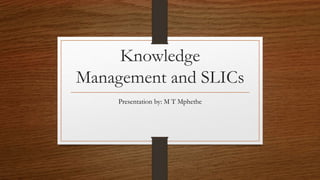
Knowledge management and SLICS
- 1. Knowledge Management and SLICs Presentation by: M T Mphethe
- 2. PRESENTATION OVERVIEW • Data, information and knowledge. • Types of knowledge. • What is Knowledge Management ? • Advantages of Knowledge Management • Barriers of Knowledge Management • Solutions to the barriers of KM • Knowledge Management in SLICs • Advantages on Knowledge Management in SLICs • Conclusion.
- 3. WHAT IS DATA, INFORMATION AND KNOWLEDGE? • Data is raw facts that have not been interpreted to become information. Data does not have meaning and can be regarded as “information about information”. • Information is data that has been interpreted and processed and is used to guide a decision making process. • Knowledge is information that has been gathered for a specific purpose and use. • All these three work together to form a complete package. For example; 500 is a number, this is raw data. When interpreted it is the number of people infected with COVID 19, this is information. The health department will then use this number to decide how many bed units it needs to purchase for a hospital, this then becomes knowledge. • The simplified process therefore becomes: Data InformationKnowledge
- 4. TYPES OF KNOWLEDGE • Tacit Knowledge- stored in a persons mind and hard to share/communicate • Organizational- information relevant to an organisation and it is owned and controlled by that particular organisation. When correctly interpreted, it leads to the organisations growth. • Formal knowledge- knowledge that is easily accessible and it is stored in books, encyclopaedias etc.
- 5. WHAT IS KNOWLEDGE MANAGEMENT? • Knowledge management (KM) is the process of creating, sharing, using and managing the knowledge and information of an organization (Girard, 2015). • It refers to a multidisciplinary approach to achieve organisational objectives by making the best use of knowledge (Ikujiro, 1991)
- 6. ADVANTAGES & BARRIERS OF KM ADVANTAGES • Improved organizational agility. • Improved decision-making and problem solving skills. • Higher rate of innovation. • Development and growth of employees • improved communication. BARRIERS • Little to no capital • Little to no incentives • The absence of the culture of sharing information • Inadaptability to change. • Organizational goals aren’t clear
- 7. SOLUTIONS TO THE BARRIERS OF KM • Knowledge management needs to be integrated into all economies, including that of the healthcare enterprise, including clinical and financial systems, procurement and the supply chain, and scheduling applications. • Knowledge workers need to be trained more effectively and investment into their training and education is needed • Knowledge workers need to work together to find creative solutions in knowledge creation and dissemination. • New skills and tools in ICT. • Knowledge workers have to extend their expertise in selecting, organizing, and preserving information must be willing to move outside the walls of the traditional library and work assiduously with technologists, faculty, and students.
- 8. KNOWLEDGE MANAGEMENT IN SLICs • A knowledge management initiative in libraries becomes imperative in order to harness the wealth, wisdom, expertise, and experiences embedded in the heads of such employees before they leave the library. This can be achieved through brainstorming, open discussions, and provision of fertile ground for creativity, sharing of ideas, organizing workshops, conferences, mentoring, web archiving, digitization, and identification and collectively addressing problems and finding solution (Poonkothai, 2016) • Knowledge Management in an academic library therefore is to ensure an all-round improvement of library staff’s capacity; promotion of relationships between libraries and library users; it promotes knowledge innovation, strengthening knowledge internetworking and quickens knowledge flow (Roknuzzaman et al, 2009).
- 9. ADVANTAGES OF KM IN SLICs • Knowledge Management will help to increase libraries’ operational efficiency and cater to the ever-increasing needs of its clientele. • . Knowledge management in Academic Institutions can be applied in five key areas such as research, curriculum development, alumni services administrative services and strategic planning (Kidwell et al. 2000). • It promotes an easy flow of information, strengthening the knowledge economy in the process.
- 10. CONCLUSION • Library professionals believe that professional education and training programs, community of practices, information technology and knowledge sharing are the important tools of knowledge management for academic libraries. Lack of knowledge sharing culture, top management commitment, incentives and rewards, financial resources and IT infrastructure are the major constraints for the implementation of knowledge management in academic libraries. Libraries, with limited budget and human resources, should utilize the current management structure and technology to implement Knowledge Management, either bottom-up or top-down (Chidambaranathan, 2015)
